Photons & Fusion Newsletter
May 2013
Photons & Fusion is a monthly review of science and technology at the National Ignition Facility & Photon Science Directorate. For more information, submit a question.
Workshops Review Steps on the Path to Ignition
Members of the NIF Team held a series of meetings and workshops to discuss the results of recent ICF experiments and to plan the "path forward" toward achieving ignition on NIF.
On May 1, a meeting of the ICF team reviewed the status of the various experimental campaigns such as shock timing, high-adiabat implosions, and mix experiments. That session was followed on the same day by a meeting of the Indirect-Drive Working Group to discuss the upcoming six-month ICF update report to Congress and the July National Nuclear Security Administration Ignition Strategic Review, as well as milestones and metrics of the path forward.
On May 7, an Indirect-Drive Simulation Methodology Working Group reviewed the modeling of NIC experiments and shared suggestions for improving modeling of experimental results.
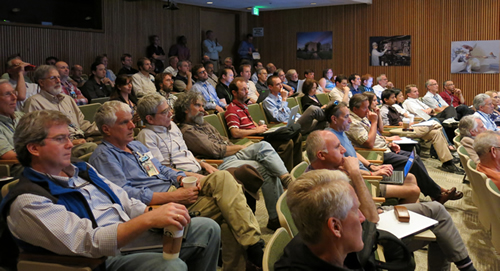 Members of the ICF team at the May 1 Ignition Path Forward Status Meeting.
Members of the ICF team at the May 1 Ignition Path Forward Status Meeting. Selective Mode Amplification in Ribbon-core Optical Fibers
Rectangular (ribbon) fiber lasers and amplifiers show promise of sidestepping the power limits of conventional circular-core fiber lasers and amplifiers. A ribbon core has a larger surface area than a circular core for the same enclosed volume, and thus radiates heat more efficiently.
In an Optics Express paper published online May 1, LLNL researchers described a novel method for scaling the power of single emitters beyond their current limits. They reported on measurements of two custom-fabricated photonic crystal ribbon fibers – one with an air-guiding silica core (a passive ribbon fiber), the other with a rare earth-doped, index-guiding core (an active ribbon fiber).
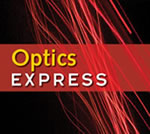
The researchers demonstrated a technique for exciting a single high-order-mode in these fibers that, in the passive fiber, achieved 90 percent mode purity (a mode is a path for the light). In the active fiber, they also demonstrated a single-mode excitation, though the modes of that fiber appeared to be non-ideal.
Configured as an amplifier, the active fiber achieved a slope efficiency of 50 percent, 10.5 watts of output power, and more than 24 dB of gain. High purity excitation was maintained through approximately 20 dB of gain with no adjustment of the launch conditions.
"Ribbon core fibers may ultimately provide the capability to produce laser amplifiers with 100 kW (kilowatts) of diffraction-limited (ideal) output power by mitigating the nonlinear effects that currently limit circular core fibers," the researchers said. "In order to scale the proof of concept reported in this paper to higher output power, additional research is needed to improve the mode uniformity, increase the width of the fiber, as well as the incorporation of mode selective gain."
Lead author Reggie Drachenberg was joined on the paper by Michael Messerly, Paul Pax, Arun Sridharan, John Tassano and Jay Dawson.
NIF Implosions at Ignition-Relevant Velocities Described in Physics of Plasmas
To achieve hot-spot temperature high enough to initiate ignition on NIF, the imploding deuterium-tritium fuel must reach a velocity of about 350 kilometers per second (km/s). During the implosion's acceleration phase, the ablation front of the imploding capsule shell is susceptible to Rayleigh-Taylor (RT) hydrodynamic instability, which can interfere with ignition if it reaches the hot spot.
Simulations indicate that at least 0.25 micrograms of capsule ablator material must remain between the fuel layer and the ablation front to separate the hot spot from RT instability growth. Increasing the capsule ablator mass to achieve that level of remaining material, however, increases the laser energy and power needed to drive the fuel pusher to the required velocity.

In a Physics of Plasmas paper published online May 9, LLNL researchers and collaborators reported on the results of recent "convergent ablator" and symmetry capsule (symcap) experiments testing the use of a capsule 20 microns thicker than the nominal 195-micron-thick ignition capsule.
When driven by a 520-terawatt, 1.86-megajoule laser pulse, the thicker capsule "appears to have achieved an implosion trajectory equivalent to the ignition (mass and velocity) goal," the researchers reported. The equivalent of fuel velocity greater than or equal to 350 km/s "has been demonstrated with high confidence," they said. "Remaining goals for the campaign include reducing the uncertainty in measuring ablator mass."
The researchers also noted that "the final optimization of velocity and mass must occur in conjunction with a more thorough physical understanding of the impact of RT growth on the final implosion."
Lead author Nathan Meezan was joined on the paper by LLNL colleagues and collaborators from Sandia and Los Alamos national laboratories, the Atomic Weapons Establishment in the United Kingdom, and General Atomics in San Diego.
LLNL Hosts International Laser Operations Workshop
The 9th International Laser Operations Workshop was held at the Laboratory May 14-16. The workshop, which drew about 90 attendees from around the world, provides a forum for operators of large-scale laser facilities to discuss issues and exchange information about laser facility operations, governance, maintenance, diagnostics, safety and security, and technology.
Along with status updates on the world's leading laser facilities, such as the Omega Laser in Rochester, Laser Megajoule in France, the Extreme Light Infrastructure (ELI) Beamlines Facility in the Czech Republic, and the Orion laser facility in the United Kingdom, the workshop included sessions on user facility goals, process and operations; optics damage management; NIF's progress toward ignition; and inertial fusion energy.
ICF National Diagnostic Working Group Meets
In-depth discussions about the purpose, performance, and future of the diagnostic equipment used on inertial confinement fusion (ICF) systems were held during a May 21-23 ICF National Diagnostic Working Group meeting at LLNL. The group reports to the National Nuclear Security Administration (NNSA).
The meeting included overviews on the scope, mission, and plans for diagnostics at NIF, the OMEGA Laser at the University of Rochester, and the Z-Machine at Sandia National Laboratories. In addition, 38 talks were presented and discussed on possible new diagnostics for the three facilities. Breakout session topics included nuclear diagnostics, x-ray spectrometers, x-ray imaging, gated x-ray detectors, and optical diagnostics. About 80 researchers from the NNSA complex and elsewhere attended in person or via Web conference.
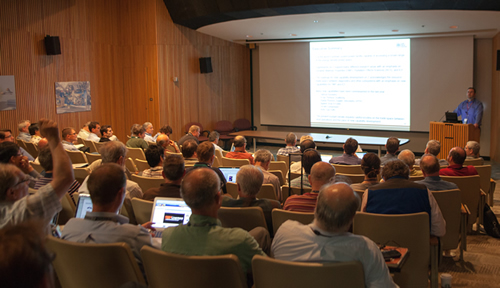 Members of the National Diagnostic Working Group receive a briefing.
Members of the National Diagnostic Working Group receive a briefing. Hohlraum Physics Working Group Plans International Collaborations
The working group on hohlraum physics met on May 21 to discuss potential collaborations on ignition science. About 55 participants from Japan, Spain, France, the United Kingdom, Los Alamos National Laboratory, the Laboratory for Laser Energetics (LLE) at the University of Rochester, the U.S. Naval Research Laboratory (NRL), and LLNL conferred via the Web.
"A very strong collaboration is forming around magnetic field effects on laser-plasma interactions," said group leader Denise Hinkel. She said scientists at LLNL, LANL, and LLE, along with collaborators in the UK, Spain, and Japan, are interested in participating in research on this topic. The Laboratory's John Moody is spearheading the effort.
"There was also strong interest from NRL and UK scientists in participating in the use of 'spectroscopic dots' to perform plasma characterization," Hinkel said. "In this scheme, small amounts, or dots, of high-Z (high-atomic-number) material are embedded in the hohlraum wall or in the capsule ablator. Either spectroscopic emission or spectroscopic imaging, or both, can be performed to learn about the plasma properties of the surrounding material."
Radiative Shocks from Spherical Cryogenic NIF Implosions
NIF has the unique capability to compress matter to unprecedented densities, pressures, and temperatures. Matter at such extreme states is of interest for studying the radiative hydrodynamics of young supernovae and other astrophysical phenomena.
In a Physics of Plasmas paper published online May 20, LLNL researchers and collaborators reported on experiments that created a spherically expanding radiative shock wave produced by a NIF inertial confinement fusion (ICF) experiment. The researchers said measurements of the temporal evolution of the expansion of the shock and luminosity from the shock-heated matter were in good agreement with radiation hydrodynamic simulations that used similar amounts of laser energy and were initialized to match the inferred stagnation pressure.
"By modifying the (ICF) capsule composition and dimensions, as well as by changing the laser drive conditions," the researchers concluded, "the shock velocity and radiative properties could be tailored to study various regimes related to supernova remnants. In these experiments, the absolute luminosity of x-ray emission from the forward and reserve shock waves can be measured and used to test hypotheses to better understand the observed x-ray emission from supernovae."
Lead author Arthur Pak was joined by LLNL colleagues and collaborators from Oxford University in the United Kingdom, the MIT Plasma Science and Fusion Center, Los Alamos and Sandia national laboratories, General Atomics, and CEA (the French Alternative Energies and Atomic Energy Commission).
Chris Barty Discusses LLNL's Role in Nuclear Photonics at CLEO/Europe-IQEC
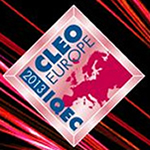
NIF&PS Chief Technology Officer Chris Barty described the Laboratory's leading role in developing gamma-ray sources and detector systems for nuclear photonics at the May 12-16 European Conference on Lasers and Electro-Optics and International Quantum Electronics Conference (CLEO/Europe-IQEC). The meeting is Europe's largest gathering of optics and photonics researchers and engineers.
At a special symposium dedicated to nuclear photonics, Barty discussed how the pursuit of this newly emerging field of nuclear science and applications using photons is being enabled by tunable, polarized, mono-energetic gamma-ray (MEGa-ray) beams. Barty originated the term "nuclear photonics" several years ago to describe LLNL's MEGa-ray-enabled nuclear activities, and it has since been recognized by the European photonics community as a distinct discipline.
LLNL Gamma-ray Technology Featured at Particle Accelerator Conference
The Laboratory's gamma-ray light source technology also was highlighted at the May 12-17 International Particle Accelerator Conference. A presentation by Fred Hartemann, Roark Marsh, and S.S.Q. Wu described gamma-ray modeling and optimization strategies relevant to nuclear photonics applications.
Marsh and colleagues also discussed the status of the LLNL X-band Test Station, a multi-bunch test station being developed to investigate accelerator optimization for future upgrades of the Laboratory's MEGa-ray technology. The test station will enable work to explore the science and technology paths required to boost the current MEGa-ray technology to a higher effective repetition rate, potentially increasing the average gamma-ray brightness by two orders of magnitude.
The major components for the test station have been designed, fabricated, installed, and aligned; assembly of RF (radio frequency) transport, test station supports, and accelerator components is currently under way. The researchers said the preliminary performance of the system with respect to processing and stability is "extremely promising."
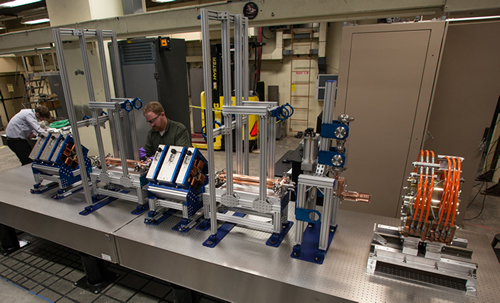 Roark Marsh (left) and David Gibson work on LLNL's X-band test station. The test station has been repositioned to optimize RF distribution for minimal loss and to allow for the expansiion of the beamline for future experiments.
Roark Marsh (left) and David Gibson work on LLNL's X-band test station. The test station has been repositioned to optimize RF distribution for minimal loss and to allow for the expansiion of the beamline for future experiments. NIF and Inertial Fusion Energy Discussed at ICENES 2013
LLNL researchers described the current status of NIF experiments and plans for developing inertial confinement fusion as a future energy source at the 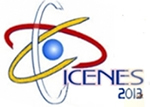 16th International Conference on Emerging Nuclear Energy Systems (ICENES) May 26-30.
16th International Conference on Emerging Nuclear Energy Systems (ICENES) May 26-30.
In a plenary address, Tom Anklam and colleagues discussed how the results from the NIF ignition program will feed in to the design of an inertial fusion energy (IFE) power plant. Anklam said NIF is capable of providing performance data at full scale for a 1,000-megawatt plant. He said a "rigorous systems approach" has been used to optimize power plant design and to develop a commercialization delivery plan.
In another presentation, Susana Reyes and colleagues described the safety basis for an IFE power plant, emphasizing the key safety design principles being adopted. Initial transient analysis results were presented that indicate that an IFE plant could meet the most stringent safety requirements.
Backlit Imaging of Axially Symmetric ICF Plasmas Reported in Applied Optics
X-ray radiography is an important implosion plasma diagnostic at NIF. In an Applied Optics paper published online May 16, LLNL researchers report that x-ray radiographs of dense plasma shells can be significantly altered by refraction of x rays that would otherwise travel straight-ray paths, and this effect can be a powerful tool for diagnosing the spatial structure of the plasma being radiographed.
In the paper, the researchers explored the conditions under which refraction effects may be observed and used analytical and numerical approaches to quantify these effects for one-dimensional radial opacity and density profiles characteristic of ICF implosions. They also showed how analytical and numerical approaches allow approximate radial plasma opacity and density profiles to be inferred from point-projection refraction-enhanced radiography data.
"This imaging technique can provide unique data on electron density profiles in ICF plasmas that cannot be obtained using other techniques," the researchers said. "The technique is particularly suited to in-flight radiography of imploding low-opacity shells surrounding hydrogen ice. It may also provide an alternative approach to timing shockwaves created by the implosion drive that are currently invisible to absorption radiography."
Lead author Jeff Koch was joined by LLNL colleagues and by Laurent P. Masse of CEA.
History Channel Documentary on 'Star Trek: Into Darkness' Features NIF
The History Channel has produced an 83-minute documentary on the physics of "Star Trek" and the making of "Star Trek: Into Darkness" which includes an extensive look at the filming of the Starship Enterprise warp core scenes at NIF last year. The filming was approved by the National Nuclear Security Administration and took place during a scheduled NIF maintenance period.
The filming was in the tradition of the classic 1982 movie "Tron," which used the Shiva Laser, NIF's predecessor, for its location shots.
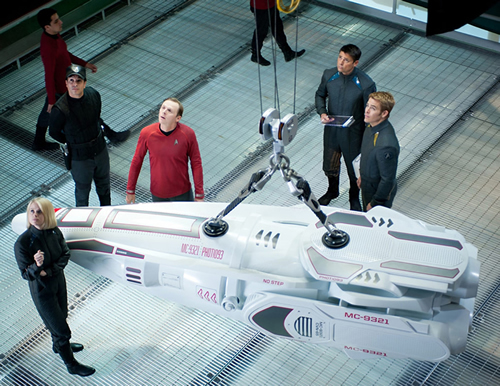 A scene from "Star Trek: Into Darkness" filmed at NIF.
A scene from "Star Trek: Into Darkness" filmed at NIF. In the documentary, "Star Trek: Secrets of the Universe," NIF&PS Principal Associate Director Ed Moses describes NIF's goal of fusion ignition, and the film's director, J.J. Abrams, thanks the NIF team for their support.
"We were there just trying to shoot a movie," Abrams told Yahoo Movies, "but all around us, these innovative scientists are working on technologies that will likely help the whole world." Abrams said he was intrigued not just by the work being done at NIF to develop renewable, clean energy sources, but at the influence "Star Trek" had on people's lives. "So many people told us 'Star Trek' inspired them to get involved in science," he said.
In the documentary, which had its premiere on May 15, other scientists weigh in on the plausibility of faster-than-light travel using warp drive, the possibility of first contact with alien life, and humanity's need and desire to venture to the stars. The documentary can be viewed online on the History Channel Website; the NIF segment begins at about the 51-minute mark.
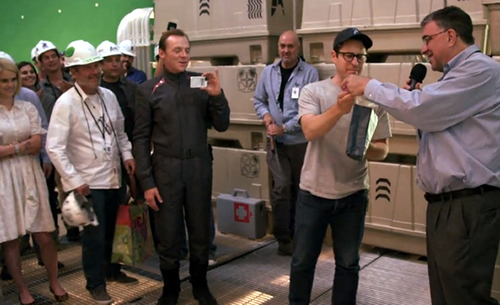 Ed Moses (right) presents a NIF "di-lithium crystal" (a sample of NIF laser glass) to film director J.J. Abrams in a scene from the History Channel documentary.
Ed Moses (right) presents a NIF "di-lithium crystal" (a sample of NIF laser glass) to film director J.J. Abrams in a scene from the History Channel documentary. NIF Visitors
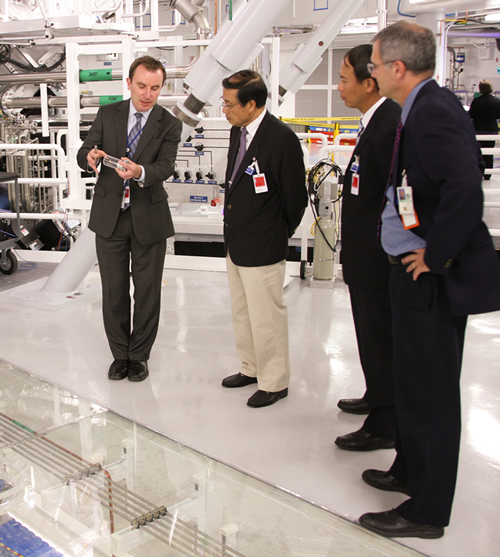 Mike Dunne of NIF&PS (left) describes a NIF hohlraum to Ambassador Toshiyuki Takano, former Japanese deputy minister for foreign affairs, during a May 23 tour of NIF. Accompanying Amb. Takano were Hiroyuki Nakai (second from right), senior manager at Itochu Technology, Inc., and Jeff Wisoff of NIF&PS. Amb. Takano served as the ambassador of Japan to Singapore, the Republic of Korea, and the Federal Republic of Germany. He is now a senior advisor to the ITOCHU Corporation.
Mike Dunne of NIF&PS (left) describes a NIF hohlraum to Ambassador Toshiyuki Takano, former Japanese deputy minister for foreign affairs, during a May 23 tour of NIF. Accompanying Amb. Takano were Hiroyuki Nakai (second from right), senior manager at Itochu Technology, Inc., and Jeff Wisoff of NIF&PS. Amb. Takano served as the ambassador of Japan to Singapore, the Republic of Korea, and the Federal Republic of Germany. He is now a senior advisor to the ITOCHU Corporation. 



